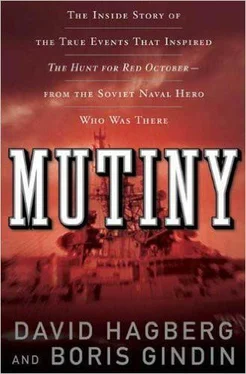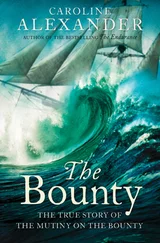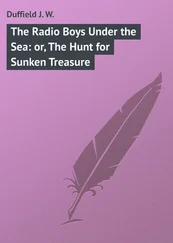“We’ve got our orders, Gennadi.”
“Da,” Kabatov said. “No matter how stupid they are, those are our guys down there. Russians.”
“Mutineers,” Demin pointed out.
“At lot of those boys are going to die before lunch if we follow our orders.”
Demin nodded. “Whatever you want to do, I’ll go along with you.”
“Could mean trouble later on,” Kabatov warned.
Demin grinned, his wide, dark eyes lighting up. “What can they do? Shoot us?”
Kabatov nodded. “They might do just that.”
It’s still too foggy to see much of anything beyond their bows, so Sablin walks out onto the port wing and cocks an ear to listen. Vice Admiral Kosov has probably sent ships out after them and possibly a couple of attack aircraft from Skirotava or maybe even Mamonovo Airfield outside Kaliningrad.
But besides that, this is the open Baltic, an area normally heavily traveled by commercial ships flying flags from a dozen different countries, the occasional warship, sometimes U.S. but most often Swedish or West German, and of course KGB patrol boats.
They are blind and they are going too fast. Sablin can almost sense the presence of other ships out there, although he can’t hear anything over the noise of the 30-knot breeze blowing across the deck and sending an icy spray over the bows when they plow into a trough.
He ducks back onto the bridge. Shein is still there, and under the circumstances Sablin doesn’t think it matters if a guard is stationed below to make sure Potulniy and his officers get out. Besides, Shein looks nervous, even frightened, as well he should be.
“Turn on the radar,” Sablin orders.
Soloviev is clearly relieved, but Maksimenko isn’t sure.
“Won’t they see us?” he asks.
“The fleet already knows where we are,” Sablin says. “The moment we were overflown, our position was pinpointed down to the meter. But now we need the radar; we can’t continue blind like this. If we collide with another ship, someone will get killed. Then we would be in serious trouble, and I don’t want that on my conscience.”
All three crewmen look at their zampolit as if he were crazy. How much more trouble can mutineers get into?
Maksimenko turns on the Palm Frond navigation radar and as soon as the set warms up the screen comes alive with targets.
“Eh tvoiu mat,” Soloviev swears half under his breath.
They are nearly out of the Irben Channel and around the Sörve Peninsula at the southwestern end of Saaremaa Island. From here they are about one hour from international waters, where Sablin believes they will be safe.
If they can make it that far.
“What’s out there?” Sablin demands. “Talk to me.”
It takes an agonizingly long time for Maksimenko to sort out what’s being depicted on the radar screen.
“Ahead of us is nothing but commercial traffic, so far as I can tell,” he says. “We’re not on a collision course with anything, but that’ll change in the next half hour.” He looks up, and at that moment he could be a deer at night caught in the headlights of an onrushing truck.
“What else?” Sablin prompts.
“We’re in trouble.”
“What do you mean?”
“A small ship is coming up fast off our starboard quarter. Less than five hundred meters out now. It’s probably a KGB patrol boat. And just coming out of the river, it looks as if every ship that was moored with us is heading our way.”
The KGB patrol craft probably couldn’t do much damage to them, and long before the fleet catches up the Storozhevoy will be out of Soviet waters. What really matters is what aircraft Fleet Headquarters has sent after them. But he does not want to call CIC again for another radar search.
The trick will be to somehow survive the next hour.
Sablin is taking it as an article of faith that the Storozhevoy will not be attacked once he reaches international waters.
Sweden and Russia have been at war with each other for three hundred plus years by this chilly morning of November 9. True, no shots are being exchanged at this moment, and haven’t been for a very long time, but Sweden does not ignore threats.
At times during the history of these two nations, Sweden has been the dominant power, while at other times, like right now, Russia, the Soviet Union, has been the vastly superior force. So when the Russians start moving their warships and military aircraft around the Baltic the Swedes definitely sit up and take notice.
The Swedish National Defence Radio Establishment, Försvarets radioanstalt, or the FRA, is responsible for signal intelligence and works closely with the Swedish intelligence service, the SI regiment. Ever since the middle of WWII, the FRA has been electronically eavesdropping on its neighbors, most especially the Russians.
The sophisticated organizations headquarters is at Lovon, just west of Stockholm, but it maintains listening posts at such places as Ostergarn on Gotland Island, which is just two hundred kilometers to the west-southwest of the mouth of the Gulf of Riga.
At this moment the Storozhevoy is about 125 kilometers away, on a heading that would appear to be taking him directly toward Stockholm.
Doris Sampsonn, a radar intecept and evaluation officer at the FRA’s Ostergarn station, suddenly sits up at her console. The room is small and dimly lit in red. A half-dozen other Electronic Intelligence (ELINT) officers man their consoles; only the murmur of the air-conditioning fan and the muted hum of low conversations mar the almost churchlike silence.
Sampsonn is receiving a strong shipborne radar signal from the southern edge of the Irben Channel, and it’s definitely a military set. A Soviet military set.
The FRA, which is a civilian organization, works under the umbrella of the Ministry of Defence. They’d been warned early this morning of some unusual activity in the Gulf of Riga, on the surface and in the air. Also, they’d been given the heads-up that the Russians were filling the airwaves with all sorts of wild, frantic messages.
Something big is in the works, and all of Sweden’s military and civilian ELINT capabilities have been placed on high alert. It’s possible, no matter how unlikely, that the Soviet Union is making its long-feared run on NATO. But they have to be sure before they sound the alarm.
Sampsonn adjusts a few controls on her console and brings up a list of Soviet warships. Each ship’s radar suite broadcasts a signal that’s different from every other ship.
She is an experienced intecept operator, but it takes her the better part of a half hour to finally come up with a positive identification and exact location.
A hotline phone connects her directly with the ELINT duty operator at FRA Headquarters at Lovon. “Sir, this is Doris Sampsonn, intercept officer at Ostergarn Station.”
“Go ahead,” the duty operator replies crisply. It’s been a busy morning.
“I’ve identified the lead Soviet ship that just came out of the Irben Channel. She’s an ASW frigate, the Storozhevoy.” Sampsonn makes another adjustment to her console. “She is on a course of three-two-zero degrees, making thirty knots.”
“The bastard is heading right at us,” the duty operator said. “What’s her present position?”
Sampsonn picked it off her screen. “Fifty-seven degrees, fifty-three minutes north latitude, twenty-one degrees, ten minutes east longitude.”
“Anything else?”
“Yes, sir. She’s just the lead ship. There are at least one dozen military sets radiating behind her, moving out of the gulf. I think the Russians are chasing after the Storozhevoy. Or maybe it’s an exercise.”
Читать дальше












